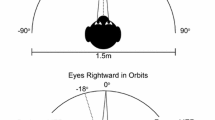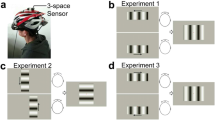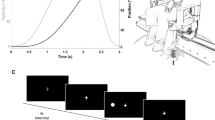Abstract
Vestibular sensors provide precise and timely information about head velocity in space. It is well established that this information is used to stabilize eyes, head and body against movements from outside, i.e., passive movements. Here, we investigate whether vestibular information also helps to monitor and guide active head movements during gaze shifts. We measured head movements during large gaze shifts toward briefly flashed targets in humans with complete vestibular loss (vestibular subjects) and in healthy controls before and after increasing their head moment of inertia. Whereas normally head movements oscillate neither in vestibular subjects nor in controls, the increase in head moment of inertia caused marked head oscillations only in vestibular subjects. We conclude that vestibular information plays an important role in the on-line guidance of active head movements and helps to correct for unexpected changes such as additional torque imposed by an increase in moment of inertia.





Similar content being viewed by others
References
Abend W, Bizzi E, Morasso P (1982) Human arm trajectory formation. Brain 105:331–348
Atkeson CG, Hollerbach JM (1985) Kinematic features of unrestrained vertical arm movements. J Neurosci 5:2318–2330
Bizzi E, Polit A, Morasso P (1976) Mechanisms underlying achievement of final head position. J.Neurophysiol. 39:435–444
Bock O (1990) Load compensation in human goal-directed arm movements. Behav Brain Res 41:167–177
Boyle R, Belton T, McCrea RA (1996) Responses of identified vestibulospinal neurons to voluntary eye and head movements in the squirrel monkey. Ann NY Acad Sci 781:244–263
Bresciani JP, Blouin J, Popov K, Bourdin C, Sarlegna F, Vercher JL, Gauthier GM (2002) Galvanic vestibular stimulation in humans produces online arm movement deviations when reaching towards memorized visual targets. Neurosci Lett 318:34–38
Bronstein AM (1988) Evidence for a vestibular input contributing to dynamic head stabilization in man. Acta Otolaryngol 105:1–6
Coimbra AJ, Lefevre P, Missal M, Olivier E (2000) Difference between visually and electrically evoked gaze saccades disclosed by altering the head moment of inertia. J Neurophysiol 83:1103–1107
Cullen KE (2004) Sensory signals during active versus passive movement. Curr Opin Neurobiol 14:698–706
Davidson PR, Wolpert DM (2005) Widespread access to predictive models in the motor system: a short review. J Neural Eng 2:S313–S319
Day BL, Reynolds RF (2005) Vestibular reafference shapes voluntary movement. Curr Biol 15:1390–1394
Gauthier GM, Martin BJ, Stark LW (1986) Adapted head- and eye-movement responses to added-head inertia. Aviat Space Environ Med 57:336–342
Glasauer S, Hoshi M, Kempermann U, Eggert T, Buttner U (2003) Three-dimensional eye position and slow phase velocity in humans with downbeat nystagmus. J Neurophysiol 89:338–354
Gresty M (1987) Stability of the head: studies in normal subjects and in patients with labyrinthine disease, head tremor, and dystonia. Mov Disord 2:165–185
Guerraz M, Blouin J, Vercher JL (2003) From head orientation to hand control: evidence of both neck and vestibular involvement in hand drawing. Exp Brain Res 150:40–49
Guitton D, Kearney RE, Wereley N, Peterson BW (1986) Visual, vestibular and voluntary contributions to human head stabilization. Exp Brain Res 64:59–69
Harris CM, Wolpert DM (1998) Signal-dependent noise determines motor planning. Nature 394:780–784
Hassler R (1956) Die zentralen Apparate der Wendebewegungen I. Ipsiversive Wendungen durch Reizung einer direkten vestibulo-thalamischen Bahn im Hirnstamm der Katze. Arch Psychiatr Nervenkr Z Gesamte Neurol Psychiatr 194:456–480
Kasai T, Zee DS (1978) Eye-head coordination in labyrinthine-defective human beings. Brain Res 144:123–141
Keshner EA, Hain TC, Chen KJ (1999) Predicting control mechanisms for human head stabilization by altering the passive mechanics. J Vestib Res 9:423–434
Lackner JR, Dizio P (1994) Rapid adaptation to Coriolis force perturbations of arm trajectory. J Neurophysiol 72:299–313
Lehnen N (2006) The effect of increased head inertia on eye-head control in human gaze shifts: Analysis and mathematical modeling of a motor system. Thesis. Faculty of Medicine. Ludwig-Maximilians-University Munich
Maurer C, Mergner T, Becker W, Jurgens R (1998) Eye-head coordination in labyrinthine-defective humans. Exp Brain Res 122:260–274
Maurer C, Mergner T, Becker W, Jurgens R (1999) Eye-head coordination in patients with chronic loss of vestibular function. In: Becker W, Deubel H, Mergner T (eds) Current oculomotor research. Plenum Press, New York, pp 433–442
McCrea RA, Gdowski GT, Boyle R, Belton T (1999) Firing behavior of vestibular neurons during active and passive head movements: vestibulo-spinal and other non-eye-movement related neurons. J Neurophysiol 82:416–428
Mittelstaedt, H (1971). Reafferenzprinzip—Apologie und Kritik. In: Kreidel WD, Plattig KH (eds) Vorträge der Erlanger Physiologentagung 1970
Peng GC, Hain TC, Peterson BW (1996) A dynamical model for reflex activated head movements in the horizontal plane. Biol Cybern 75:309–319
Peng GC, Hain TC, Peterson BW (1999) Predicting vestibular, proprioceptive, and biomechanical control strategies in normal and pathological head movements. IEEE Trans Biomed Eng 46:1269–1280
Robinson DA (1963) A method of measuring eye movement using a scleral search coil in a magnetic field. IEEE Trans Biomed Eng 10:137–145
Roy JE, Cullen KE (2001) Selective processing of vestibular reafference during self-generated head motion. J Neurosci 21:2131–2142
Roy JE, Cullen KE (2004) Dissociating self-generated from passively applied head motion: neural mechanisms in the vestibular nuclei. J Neurosci 24:2102–2111
Shadmehr R, Krakauer JW (2008) A computational neuroanatomy for motor control. Exp Brain Res 185:359–381
Tanaka H, Krakauer JW, Qian N (2006) An optimization principle for determining movement duration. J Neurophysiol 95:3875–3886
Tangorra JL, Jones LA, Hunter IW (2003) Dynamics of the human head-neck system in the horizontal plane: joint properties with respect to a static torque. Ann Biomed Eng 31:606–620
Todorov E (2004) Optimality principles in sensorimotor control. Nat Neurosci 7:907–915
van Beers RJ, Haggard P, Wolpert DM (2004) The role of execution noise in movement variability. J Neurophysiol 91:1050–1063
von Holst E, Mittelstaedt H (1950) Das Reafferenzprinzip (Wechselwirkung zwischen Zentralnervensystem und Peripherie). Die Naturwissenschaften 37:464–476
Wagner R, Galiana HL (2001) Unifying vestibulo-ocular reflexes. In: Proceedings of the 23rd annual international conference of the IEEE. Engineering in Medicine and Biology Society, pp 849–852
Wilson VJ, Melvill Jones G (1979) Mammalian vestibular physiology. Plenum Press, New York
Wolpert DM, Flanagan JR (2001) Motor prediction. Curr Biol 11:R729–R732
Wolpert DM, Miall RC (1996) Forward models for physiological motor control. Neural Netw 9:1265–1279
Wolpert DM, Ghahramani Z, Jordan MI (1995) An internal model for sensorimotor integration. Science 269:1880–1882
Zangemeister WH, Jones A, Stark L (1981) Dynamics of head movement trajectories: main sequence relationship. Exp Neurol 71:76–91
Acknowledgments
We thank Thomas Eggert and Thomas Fritz for discussions and advice, and Judy Benson for copy-editing the manuscript. This work was supported by the Bundesministerium für Bildung und Forschung (BCCN Munich 01GQ0440).
Author information
Authors and Affiliations
Corresponding author
Rights and permissions
About this article
Cite this article
Lehnen, N., Büttner, U. & Glasauer, S. Vestibular guidance of active head movements. Exp Brain Res 194, 495–503 (2009). https://doi.org/10.1007/s00221-009-1708-6
Received:
Accepted:
Published:
Issue Date:
DOI: https://doi.org/10.1007/s00221-009-1708-6




